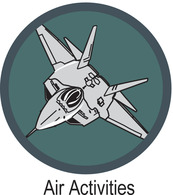- Recognition
- a) Be able to recognise by sight twelve types of aircraft.
- b) Recognise and describe the difference between the piston engine and the turbojet engine and show that you understand how the power of these units is adapted to propel an aircraft.
- Weather
- a) Know the various types of cloud and the weather usually associated with each type, and what effect these formations have upon the flight performance of an aircraft.
- b) Find out some of the factors required to estimate the time it would take to cover a certain distance in the air.
- c) Show a proficiency in interpreting weather maps.
- Theory
- a) Describe the correct procedure for radio communication with the control tower or other aircraft on the ground and in the air.
- b) Do one of the following:
- i) give a talk to your Patrol or Troop for at least five minutes on Australia’s early aviation history
- ii) compile a report on Australia’s aviation pioneers
- iii) find out, by discussion with a commercial pilot or flight instructor, what the main responsibilities are in performance of their work.
- Activity
- a) Arrange to visit a Scout or Air Activity Centre and/or aerodrome, and find out:
- i) who is responsible for the maintenance of airport services
- ii) what is the function of a control tower
- iii) what is the function of an Air Traffic Controller
- iv) what airlines/aircraft use the aerodrome.
- b) Complete five of the tests from one of the following familiarization electives, or complete the aeromodelling task.
LIGHT AIRCRAFT FAMILIARISATION
- a) Learn how to assist correctly in ground handling of an aircraft and find out the safety precautions required whilst refueling.
- b) Describe cockpit checks performed by the pilot prior to takeoff and prior to the landing approach.
- c) Describe the primary effect of aircraft controls.
- d) Have two flights in a light aircraft.
- e) Know and demonstrate an elementary knowledge of aircraft controls – control column, rudder pedals, throttle, flaps, trim tabs, mixture control.
- f) With the use of a map, compass and protractor, show how to plot a course between two towns.
- g) Know the procedure to adopt in the event of an emergency.
OR
GLIDING FAMILIARISATION
- a) Learn and demonstrate handling and parking.
- b) Learn and demonstrate launching signals.
- c) Act as a satisfactory member of a ground-handling crew in an actual landing.
- d) Know the procedure to adopt in the event of an emergency.
- e) Have had two flights in a glider.
- f) With the use of map, compass and protractor show how to plot a course between two towns.
OR
AEROMODELLING
Construct two models selected from the following classifications (use of kit permitted). The models shall have the minimum flight times listed below:
- a) glider (hand launched) 17 seconds
- b) glider (hand launched) aerobatics
- c) rubber powered one minute
- d) engine powered (maximum 15 seconds motor run) two minutes.
|

